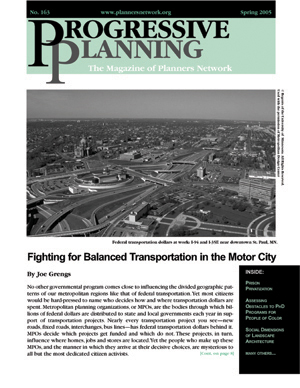By Gregory D. Squires and Charis E. Kubrin
The 1977 Community Reinvestment Act (CRA) has generated trillions of dollars for urban and rural neighborhoods that had traditionally been redlined by financial institutions. But the Bush administration, with the help of its financial service industry friends, continues its assault on this law and on the low- and moderate-income communities the law has served. As a famous newspaper headline read when Gerald Ford refused financial assistance to New York City in the midst of its fiscal crisis thirty years ago, George Bush has basically told the nation’s cities and many of its rural communities to drop dead.
The CRA requires federally regulated depositories (e.g., banks and thrifts) to provide loans, investment capital and other financial services to neighborhoods that have long been underserved by financial service providers, but to do so consistent with safe and sound lending practices. No quotas are required. It does not mandate credit allocation, just good loans to good borrowers.
The CRA has triggered $4 trillion in loans and investments for low- and moderate-income communities, according to the National Community Reinvestment Coalition, which monitors banking policies and practices. Between 1993 and 2002, (the CRA was most vigorously enforced in the mid-to-late 1990s) loans to blacks increased by 79 percent, to Hispanics by 185 percent and to whites by 30 percent. At the same time, loans to low- and moderate-income borrowers grew by 90 percent and to middle-income buyers by 51 percent.
Researchers at Harvard, the Federal Reserve Board, the US Treasury and various academic institutions report that CRA has worked for lenders and communities alike. Traditionally underserved neighborhoods are getting more loans, while lenders are generating revenue off of profitable loans—and the CRA has been instrumental in leveraging them.
Our own research has found that one outcome of such reinvestment as spurred by the CRA has been a reduction of crime. Access to capital, and other economic resources, reduces the incentive to engage in illegal activities. When the opportunity structure permits people to pursue valued goods via “acceptable” means, the likelihood of resorting to deviant or criminal means goes down. In a case study of Seattle, Washington we found that each $10,000 increase in a neighborhood’s average mortgage loan led to a reduction of 1.25 violent crimes per 1,000 residents—even after accounting for poverty, unemployment, population turnover and other factors commonly associated with crime. For a typical Seattle neighborhood this translates into a reduction of 6.25 violent crimes each year. And the effects were even stronger in our analysis of lenders covered by the CRA.
But the law is under attack. Initially the CRA required federal financial regulatory agencies to examine the lending, investment and service activities of all covered institutions with assets over $250 million. Smaller lenders had a more streamlined review focused just on their lending activity. But under Bush, the Office of Thrift Supervision (OTS) raised this threshold to $1 billion for all thrift institutions. The Federal Deposit Insurance Corporation (FDIC), Comptroller of the Currency (OCC) and Federal Reserve Board issued proposed rules in mid-February that would dilute enforcement for lenders they supervise with assets between $250 million and $1 billion. For example, the investment test would be eliminated and these lenders would no longer have to publicly report where they make small business or community development loans. In a more sweeping rollback, OTS subsequently eliminated the mandatory investment and service tests, making these voluntary for large lenders. These changes threaten to cut the number of branch banks in low- and moderate-income communities, reduce financing for affordable housing development, undercut a range of housing and business development reinvestment activities and make city streets more dangerous.
Particularly at a time when predatory lending has emerged as the most critical consumer finance issue and financial wrongdoing is surfacing across of range of financial service providers (Riggs National Bank, Fannie Mae, Marsh & McLennan), more transparency rather than less is in order. The CRA should be strengthened, not weakened.
For example, the law should cover all mortgage lenders (e.g., mortgage brokers, insurers, securities firms) and not just depository institutions. Lender CRA evaluations should be downgraded for those engaged in predatory lending. Predatory lending practices include charging far more in fees than can be justified by the risk, lending based on the value of the property with no regard to the borrower’s ability to repay (which often leads to foreclosure and loss of a family’s life savings) and targeting minority and elderly households (as is currently the case) who are most vulnerable to high-pressure sales tactics and other exploitative practices.
As Robert Rubin, a director of Citigroup and former Treasury secretary, and Michael Rubinger, president of Local Initiatives Support Corporation, which finances community development projects, both concluded, “Low-income families can be part of the mainstream economy only if they can buy homes, start businesses and live in stable, vibrant communities. If the United States is to compete globally, we need everyone to contribute. In these uncertain economic times, keeping the Community Reinvestment Act strong is in the interest of all Americans.”
The Bush administration’s attacks on cities and distressed rural communities undercut efforts to achieve the “ownership society” it purports to endorse. The CRA has been a vital tool for creating and increasing access to capital for many who have long been locked out of the economic mainstream. Keeping it strong is clearly in the interest of all of us.
Gregory D. Squires and Charis E. Kubrin teach in the Sociology Department at George Washington University.
